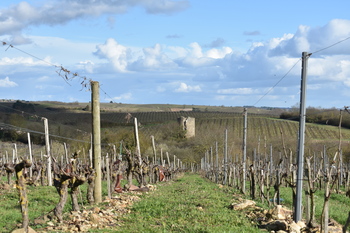
 |
| Domaine des Forges has been run by the Branchereau family since 1890. The domaine, now in the hands of Stéphane Branchereau and his wife Séverine, spreads over 47 ha of vineyards: a little Sauvignon Blanc and Chardonnay, some Gamay, Cabernet Franc and Cabernet Sauvignon, and 27 ha of Chenin Blanc. The Chenin parcels include 3 ha in Quarts de Chaume and other plots in three separate crus of Savennières: Moulin du Gué, Clos du Papillon and Roche aux Moines. Domaine des Forges crafts three outstanding single-vineyard Savennières from these parcels. Farming practices: sustainable. Grass is allowed to grow between the rows in order to avoid erosion and improve the health of the soil. Preventive health techniques are used, such as ébourgeonnage (the removal of unwanted new vine shoots) and effeuillage (the removal of old leaves). No herbicides or pesticides are used. |
| Domaine des Forges Website |
| Savennières - Moulin du Gué |
| This 1.5 ha parcel is located on the plateau of the village of Savennières, opposite the "Moulin du Gué". Shallow soil of schist and sand. The grapes are manually harvested by successive passes through the vineyard. Some of them have a little botrytis, which brings complexity and richness to the wine. During the fermentation, the temperature is closely monitored to highlight Chenin's natural aromas. The wine goes through partial malolactic fermentation, and is aged on the lees for about 11 months in 400 liter barrels, with some bâtonnage. Intense and complex on the nose, with notes of hazelnut, spice and fruit confit on the palate, this Savennières benefits from decanting. Drink young within 4 years, or wait 8 to 10 years for tertiary aromas. 833 cases produced. |
| Savennières - Le Clos du Papillon |
| 400 meters away from Moulin du Gué and located on the hillside, this Clos is only shared by three producers -Baumard is another. Filled with volcanic rocks and deep schistous soils, the vineyard is known for its classically dense Savennières wines. The grapes are manually harvested by successive passes through the vineyard. Some of them have a little botrytis, which brings complexity and richness to the wine. During the fermentation, the temperature is closely monitored to highlight Chenin's natural aromas. The wine goes through partial malolactic fermentation, and is aged on the lees for about 11 months in 400 liter barrels, with some bâtonnage. This Savennières benefits from decanting. Drink young within 4 years, or wait 8 to 10 years for tertiary aromas. 416 cases produced. |
| Savennières - La Roche aux Moines |
| Of the 146 ha planted in Savennières AOC, Savennières-Roche-aux-Moines covers 33 hectares - of which only 22 ha are under production, shared by 8 domaines. It became its own appellation beginning with the 2011 vintage. Typically shortened to Roche-aux-Moines, the same way Coulée-des-Serrant is usually expressed without the "Savennières" prefix. This incredible vineyard is composed of shale, Aeolian sand and veins of volcanic rock. The grapes are manually harvested at optimum maturity by two successive passes through the vineyard. During the fermentation, the temperature is closely monitored to highlight Chenin's natural aromas. The wine goes through partial malolactic fermentation, and is aged on the lees for about 11 months in 400 liter barrels, with some bâtonnage. Age at least 5 years before serving. 208 cases produced. |
| Copyright © 2002-2017 VOS Selections, Inc. |